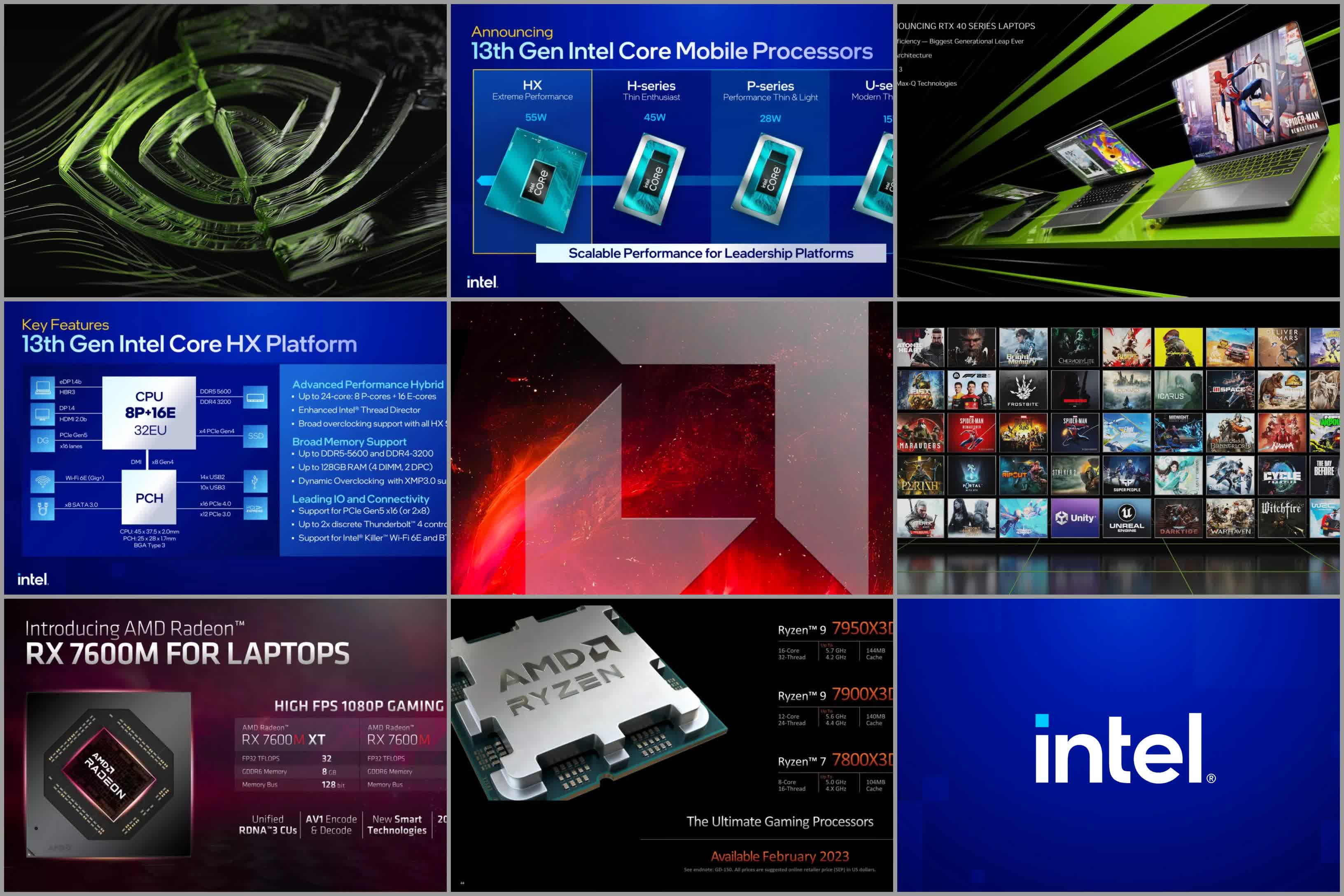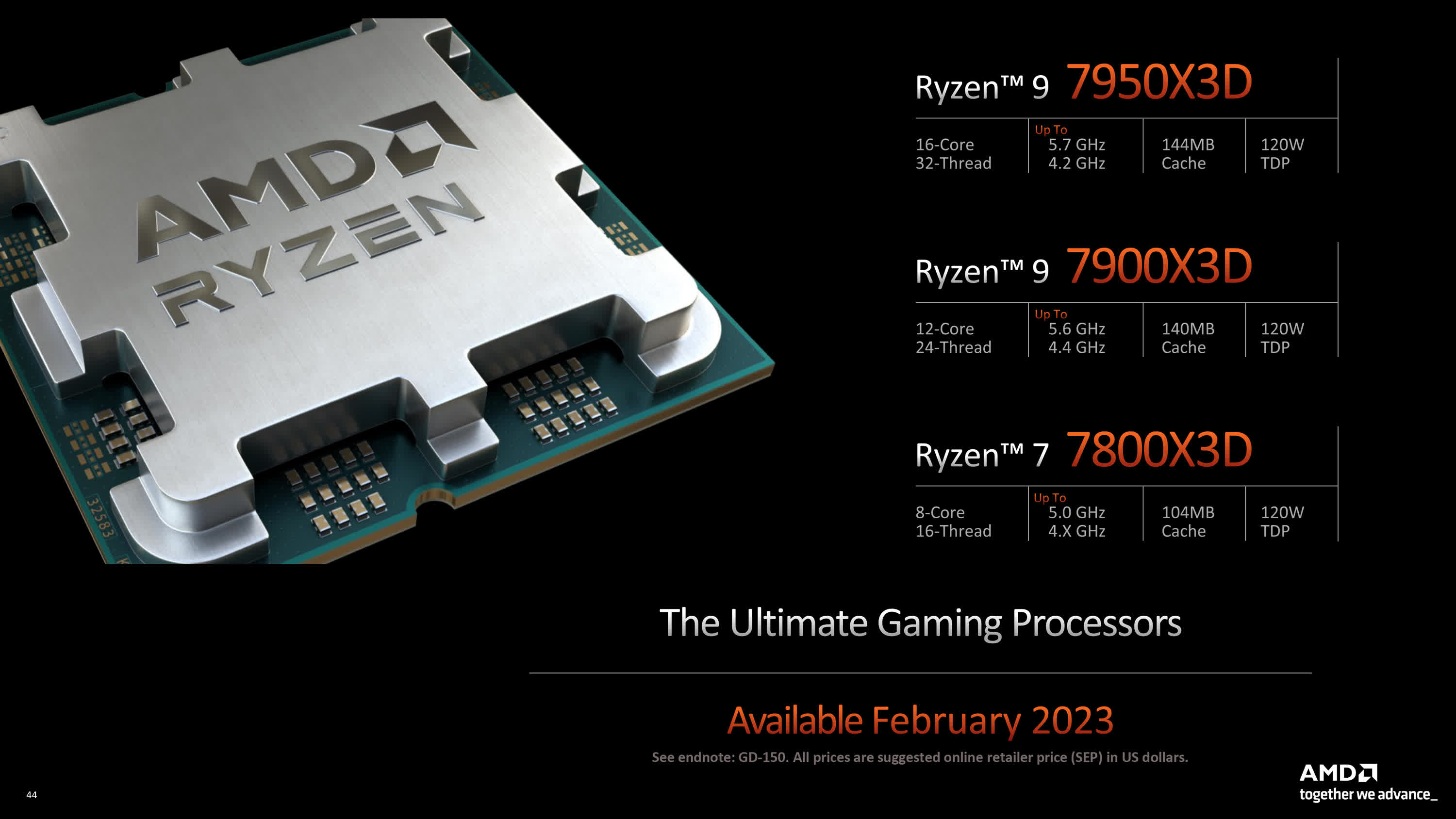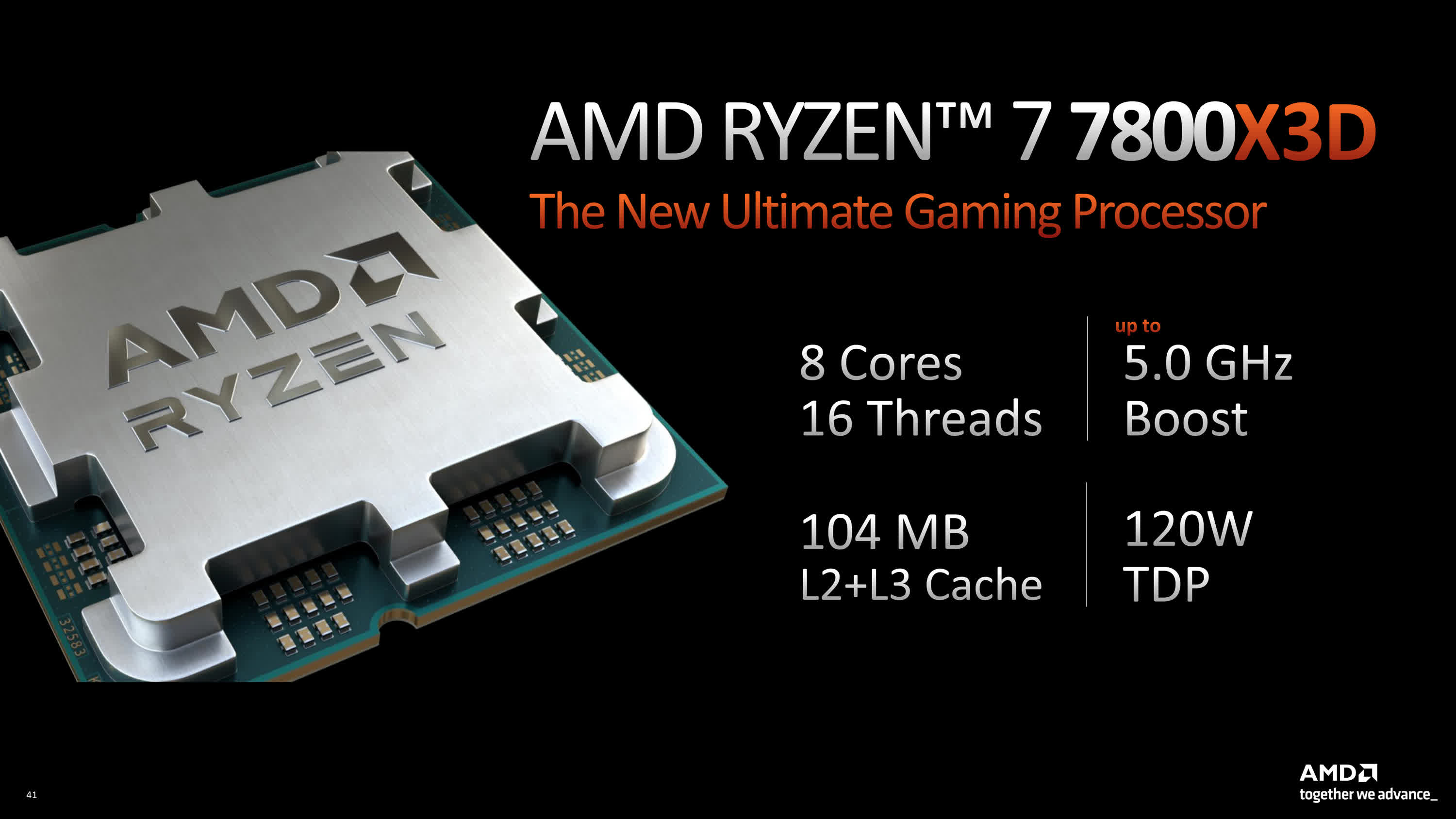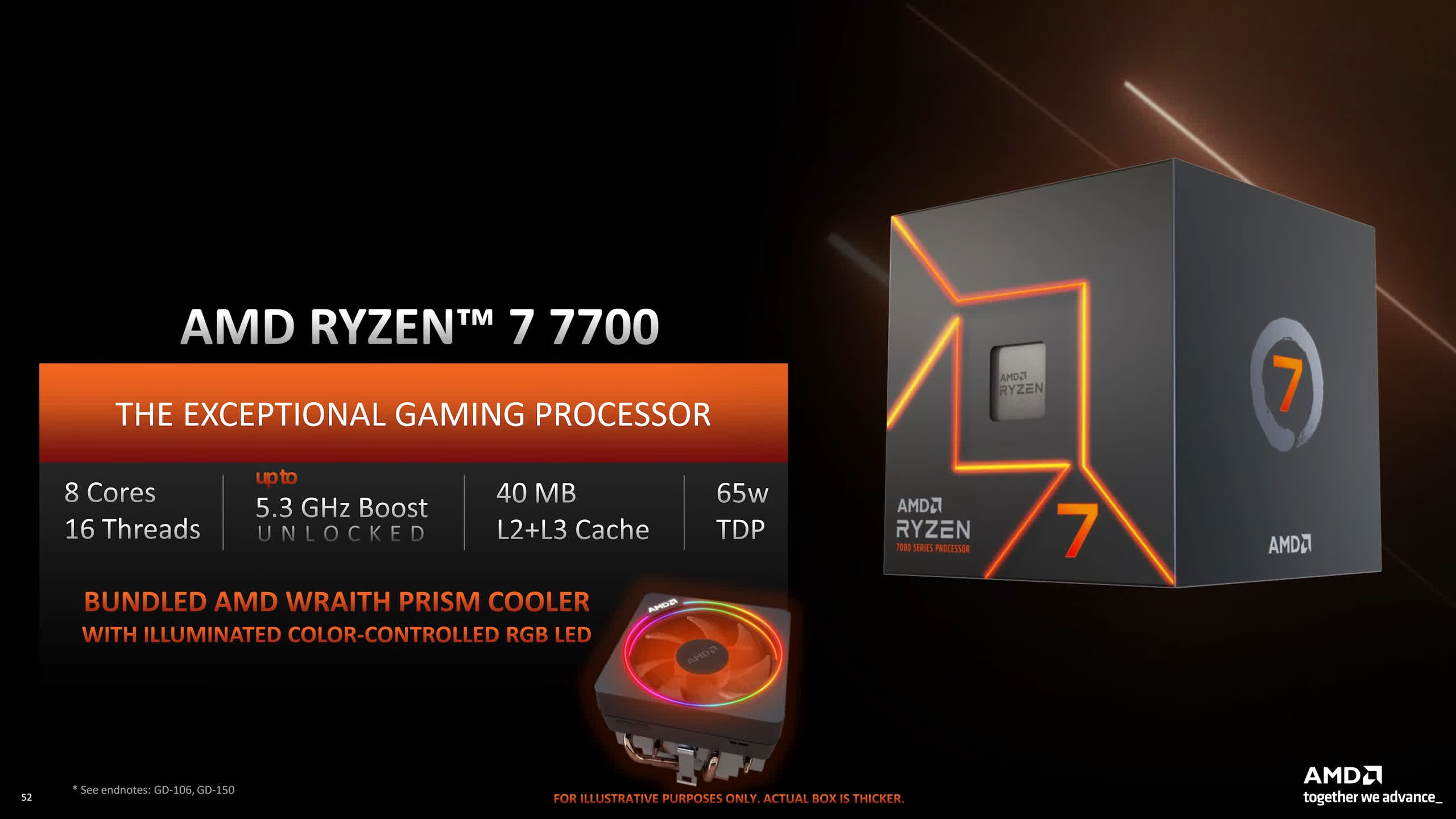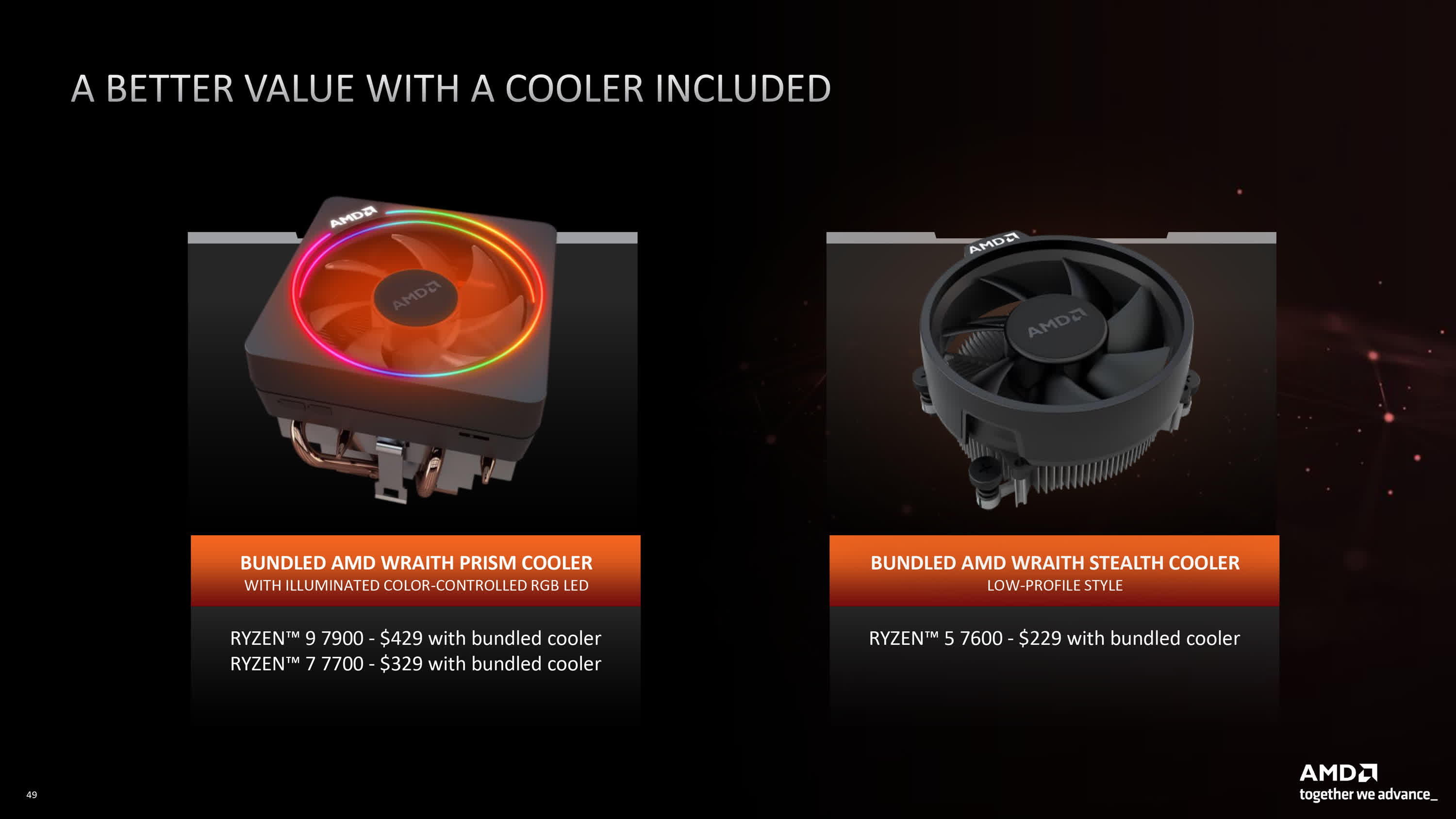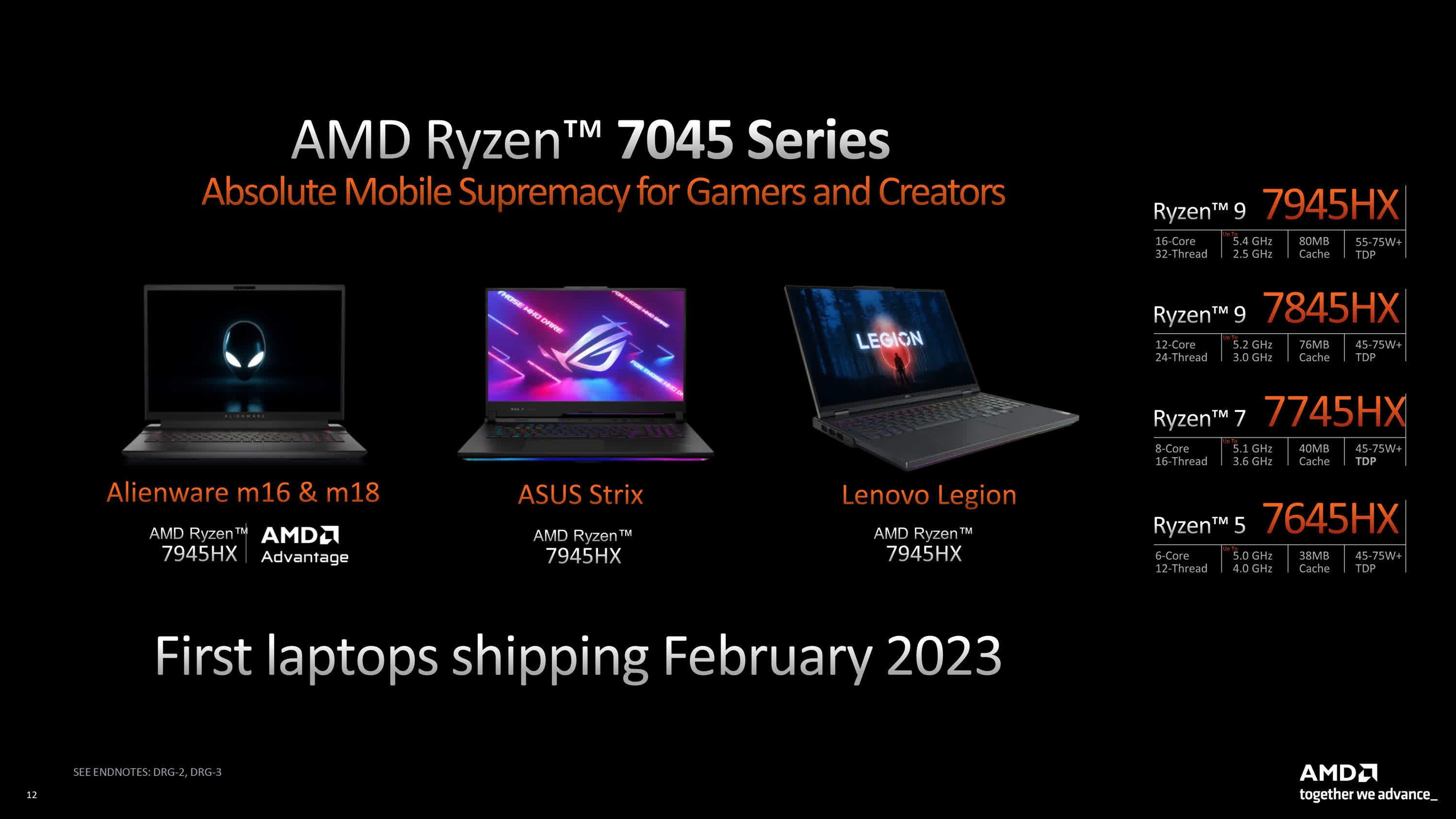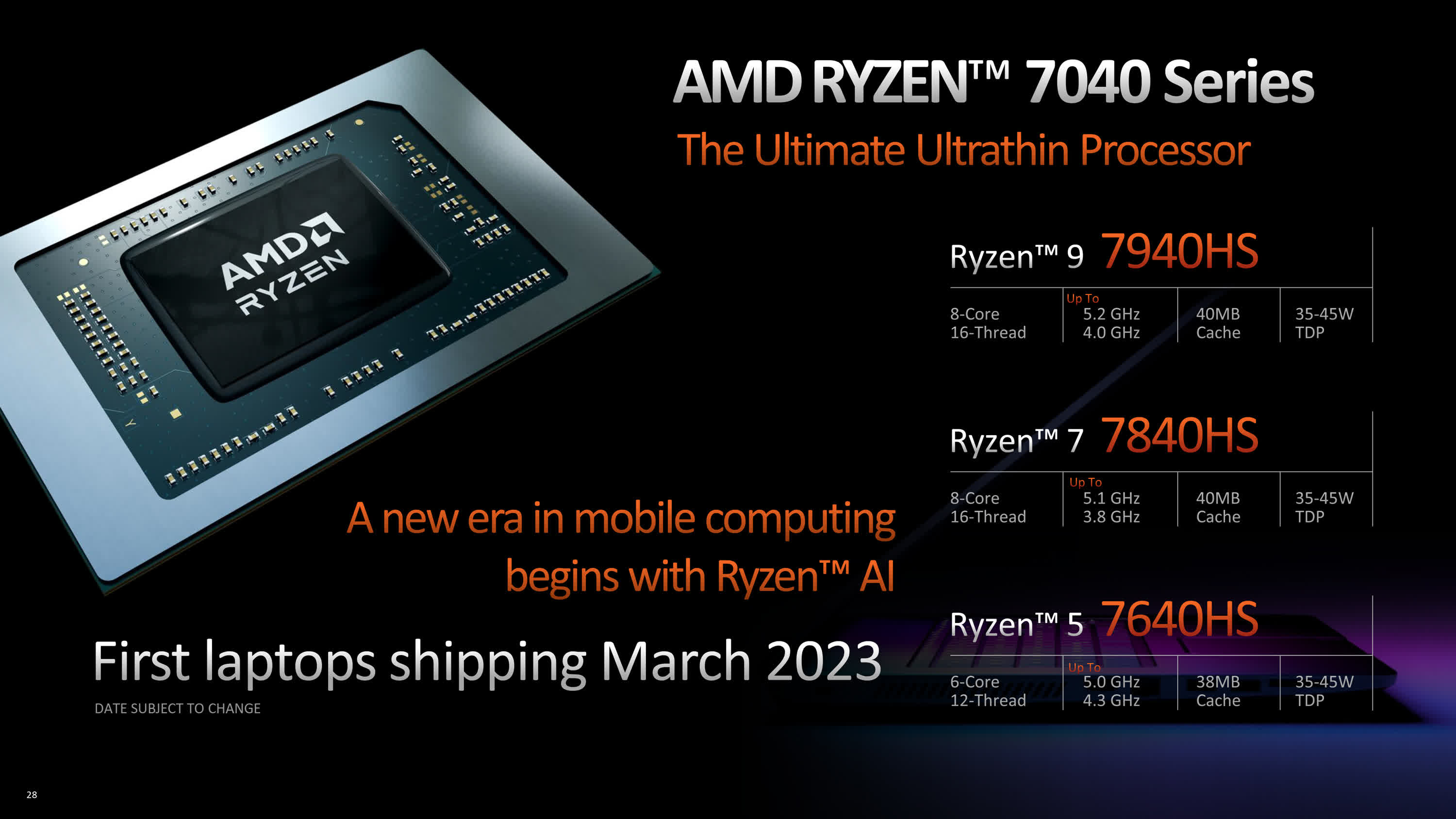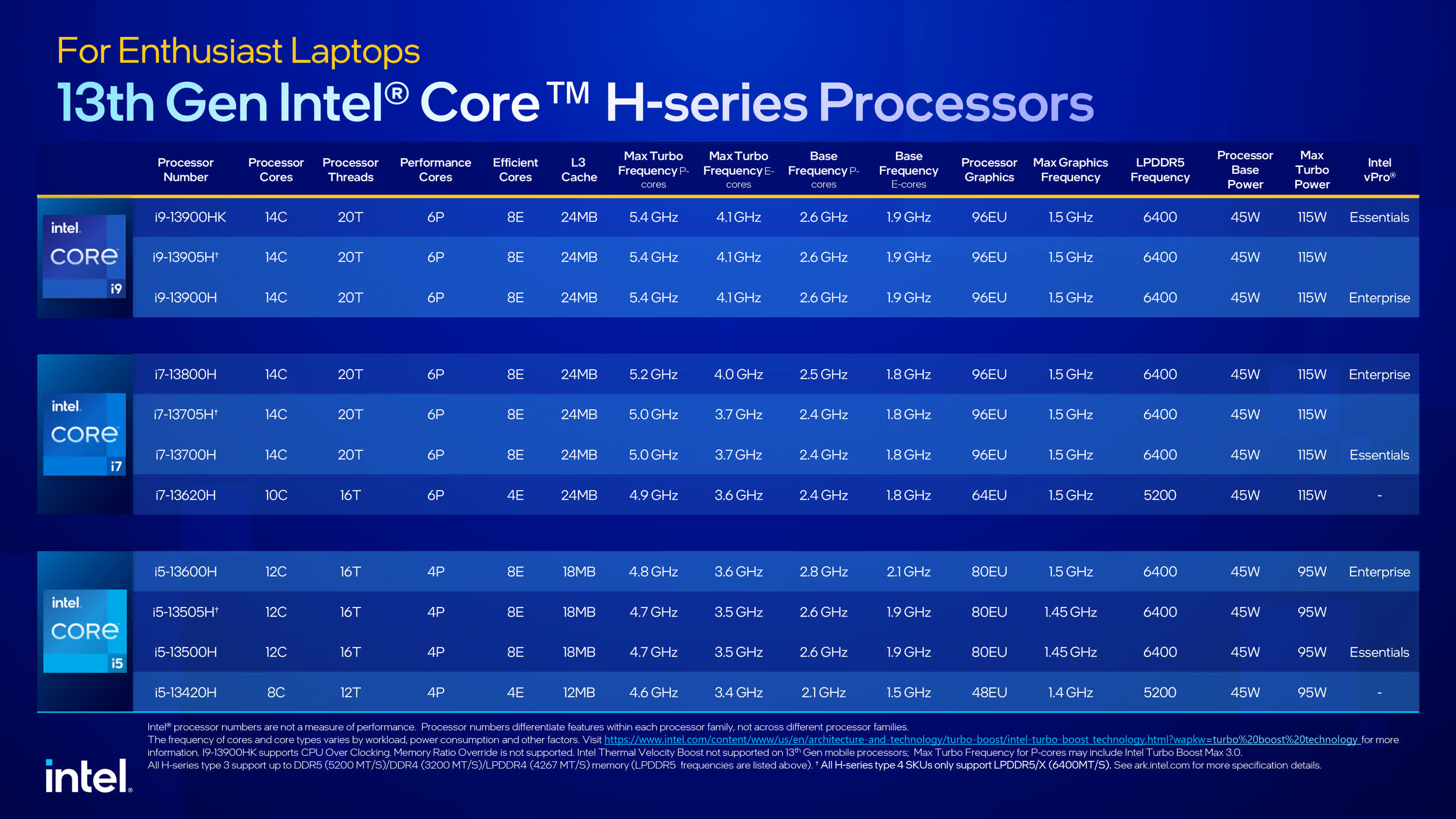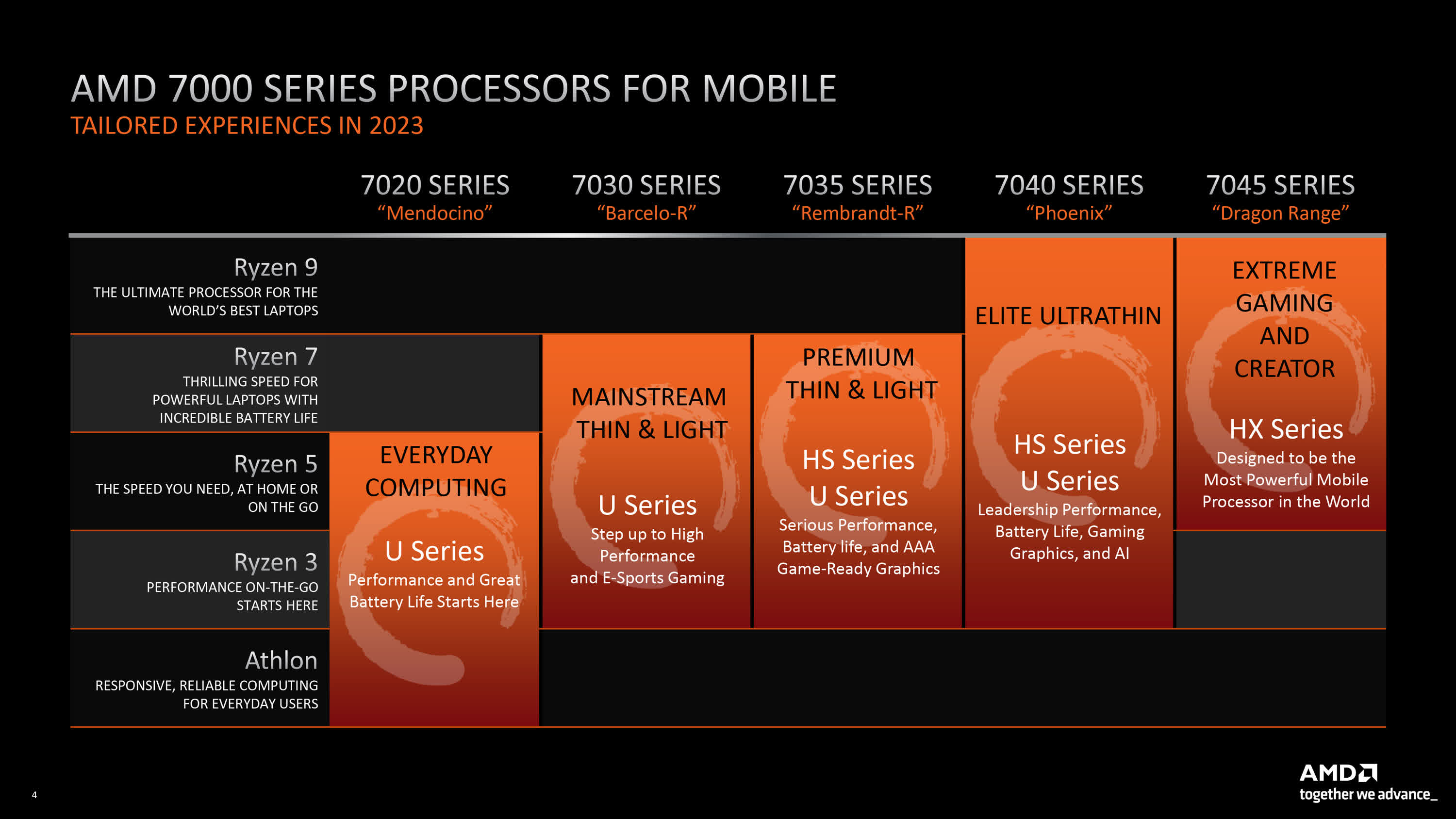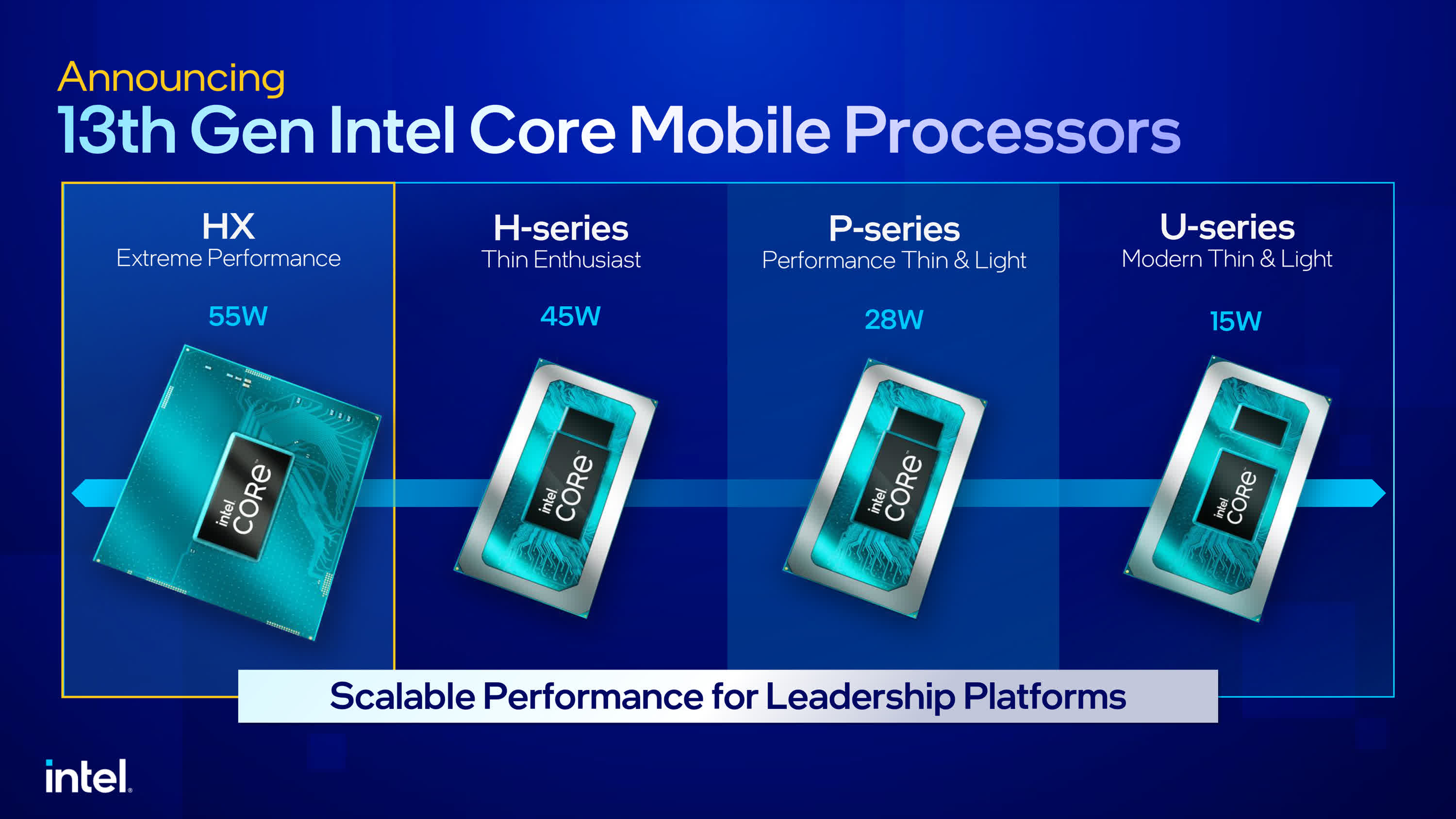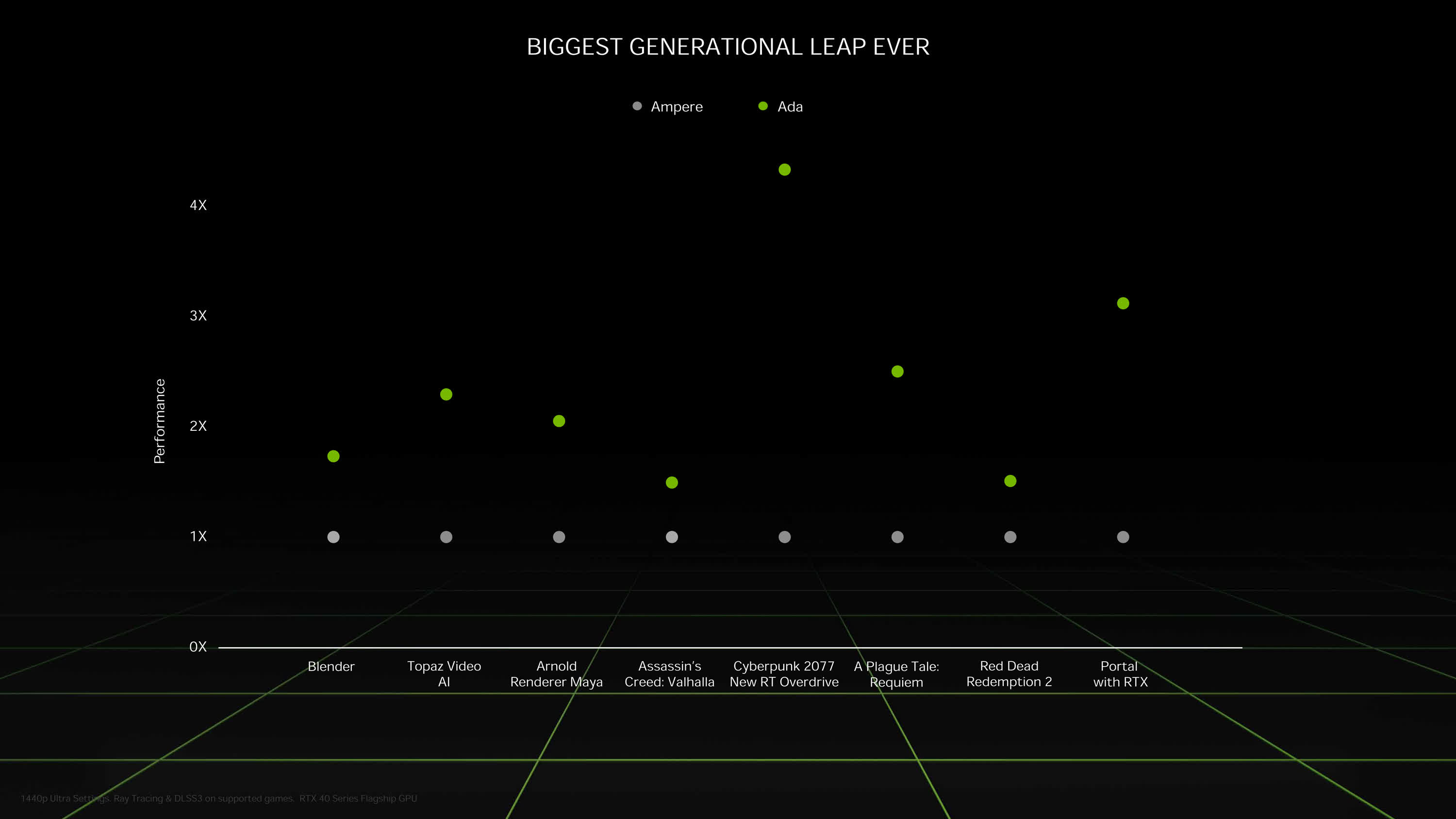This should be a good time for a CES 2023 news recap and analysis, with tons of PC hardware announcements as expected, and AMD having just concluded its presentation. So let's run through all the interesting stuff and give our thoughts on what's been shown...
AMD 3D V-Cache CPUs
Starting from the most recent reveal this morning, AMD's new Ryzen 7000 3D V-Cache CPUs. V-Cache debuted on the popular Ryzen 7 5800X3D last year, stacking a cache die on top of the CPU chiplet to significantly increase L3 cache capacity from 32 to 96 MB. The same sort of technology is now being deployed to Zen 4 Ryzen 7000 processors as well.
While before AMD only launched one V-Cache processor, with Zen 4 we are getting three new options. There's the 7800X3D offering 8 cores and 16 threads, the 7900X3D offering 12 cores and 24 threads, and the 7950X3D with 16 cores and 32 threads. All are 120W parts and will be available in February.
There's a couple of interesting things to note about these specs. First is clock speeds. With the 7950X3D we see the same 5.7 GHz max clock as the 7950X, and unlike with the 5800X3D vs 5800X there's no reduction in turbo speed. However, to drop the TDP from 170W to 120W, base clocks are lower and we'd expect all core frequencies in typical applications to be lower than that of the 7950X. Same with the 7900X3D, which has the same 5.6 GHz max frequency as the 7900X.
However this isn't the case for the 7800X3D, which lists just a 5.0 GHz max turbo clock. This is down from the 5.4 GHz max frequency we saw for the Ryzen 7 7700X. The large cache should offset this clock speed drop like we saw for 5800X3D vs 5800X, though the frequency reduction is larger with the Zen 4 8-core part compared to Zen 3.
Also interesting are the total cache figures. AMD lists both L3 and L2 cache combined, and the 7800X3D numbers make perfect sense. 32MB of on-chiplet L3 cache, 64 MB of 3D V-Cache and 8 MB of L2 cache, with 1MB per core with Zen 4. This totals 104 MB. With the Ryzen 9 parts though we have 140MB and 144MB of combined cache listed. This suggests only one of the two CPU core chiplets has received V-Cache. The 7950X already has 64MB of L3 plus 16MB of L2, or 80MB of total cache. To jump up to 144MB as seen here there must be just 64MB of additional V-Cache, which implies one set of V-Cache on one chiplet, while the other chiplet is just a regular chiplet with no V-Cache.
That's an interesting configuration that seems gaming optimized, as most games avoid using more than one chiplet on AMD's dual-chiplet Ryzen 9 parts. It wouldn't make a lot of sense to add V-Cache to a chiplet that won't actually be used for gaming. But it also means that thread scheduling needs to be spot on for these parts, always allocating games to the CPU chiplet that contains V-Cache.
Otherwise these new Ryzen 9 V-Cache parts look ideal for people that use their systems for both gaming and productivity: something like the 7950X should offer excellent multi-thread performance while also having top-end speed for gaming enhanced through a huge L3 cache on one die.
AMD is claiming with their benchmarks – that you should definitely take with a huge grain of salt – that the 7800X3D is between 21 and 30 percent faster than the 5800X3D across a four game sample at 1080p using high image quality. That's a substantial gain, and should push this part into the top spot on the gaming chart.
AMD is claiming a 13 to 24 percent performance lead over the Core i9-13900K with the 7950X3D, previously the 13900K has been the top gaming part, but AMD's marketing is suggesting otherwise. No direct performance comparisons were shown pitting Zen 4 against Zen 4 V-Cache, but we know the 5800X3D, 13900K and Zen 4 are all quite competitive so these new X3D parts should be around 15% faster than Zen 4 - a similar uplift from V-Cache with the previous generation.
Hopefully this will breathe some life into the AM5 platform which has been struggling from low sales and interest compared to AM4.
New affordable AMD CPUs: Non-X Ryzen 7000
The next major announcement from CES has been the introduction of new affordable processors from both AMD and Intel - we've got the 65W non-X Zen 4 parts from AMD, and the 13th-gen non-K lineup from Intel.
On the AMD side, the Ryzen 9 7900 is basically a 7900X with the max clock dropped from 5.6 to 5.4 GHz and lower multi-core clocks as the TDP drops from 170W to 65W. This part will come in at $430, down from the 7900X's launch price of $550, although these days the 7900X can be found for around $460.
Similar story for the Ryzen 7 7700 and Ryzen 5 7600. The TDP drop isn't as dramatic here as both parts go from 105W to 65W, and clock speeds are down either 100 or 200 MHz in terms of boost clock.
The big improvement is pricing, with the 7700 sitting at $330 and the 7600 at $230, which are $70 discounts compared to the launch pricing of the X models. However like with the 7900 they're less of a discount relative to current pricing, as the 7700X can be found for just $345, while the 7600X has occasionally fallen to $260.
When buying a non-X model you'll also get a box cooler, the Wraith Prism for the Ryzen 7 and 9, and a Wraith Stealth for the 7600. Zen 4 CPUs previously did not come with a box cooler, but it makes sense that the more affordable budget models would go back to including these.
New Intel affordable CPUs: Raptor Lake non-K 65W
Intel has also announced a huge suite of new 13th-gen Core non-K CPU models for affordable systems. These include standard locked models with integrated graphics, as well as F models without graphics, most of which are 65W parts. There's also the T series, which drops the TDP further to 35W, though these parts are mostly destined for pre-builts.
The core configuration is identical to Intel's unlocked Raptor Lake models for the higher-end parts in the lineup. So, for example, the Core i7-13700 has 8 P cores and 8 E cores, which is also true of the 13700K. However, clock speeds are lower, dropping from 5.4 to 5.2 GHz on the P cores and 4.2 to 4.1 GHz on the E cores.
When run in its TDP limited state at the 65W default, all core frequencies will be a lot lower than the 125W unlocked models - however many motherboards will run these in a power unlimited state by default, reducing the margins and increasing performance.
While all of these parts are 13th-gen models, Intel is using a mixture of Raptor Lake and Alder Lake silicon, though it's not 100% clear which CPUs use which architecture.
It's expected that the Core i7 and Core i9 parts are Raptor Lake, while the Core i5s and below are refreshed Alder Lake. But that doesn't mean we are seeing the exact same configurations as 12th-gen. For example, the 13400F is now a 10-core processor with 6 P cores and 4 E cores, while the older popular 12400F was just a six-core model, with 6 P cores and no E cores. That means the new Core i5 lineup now has E cores.
The Core i3 models are still quad-core processors though with no E cores and seem to be just higher clocked variants of 12th-gen parts.
Pricing has increased for these locked processors compared to the previous generation. For example, the Core i5-13400F is now $196 (RCP), compared to $167 for the 12400F at launch – has since increased to $184 in 2023. RCP is Intel's "recommended customer price" which is not a true MSRP - the 13400F is actually listed for $210 at Newegg, pitting itself just $20 less than the Ryzen 5 7600 which should be an interesting battle.
Similarly, the Core i3-13100F is listed with an RCP of $109, but on Newegg it's $125. The Core i7-13700F is $380, slotting between the Ryzen 7 7700 and Ryzen 9 7900, while the new Core i9-13900F comes in at $570, which is the exact same price as the Ryzen 9 7950X goes for these days.
Most of the manufacturer provided benchmarks, whether it's Intel or AMD, isn't that relevant as both are launching new models at the same time. What is relevant is seeing how these 13th-gen parts compare to the Zen 4 parts at the same price point, whereas Intel and AMD mostly focused on either gains compared to the previous generation, or comparisons to their competitor's last-gen parts.
For example, AMD compared the Ryzen 5 7600 to the Core i5-13600K and made a point that their CPU is 65W while the 13600K is 125W. This is completely irrelevant now as there's a Core i5-13600 at 65W. Of course, they couldn't have tested each other's unreleased CPUs when making these charts, so for these models benchmarking is going to be king and we'll start to see those results very soon.
Intel's new 13th-gen models are available now, while the Zen 4 non-X chips are debuting on January 10th, so look out for our reviews soon.
New laptop hardware: High-end mobile CPUs
All three big hardware vendors are launching new laptop chips in the first quarter of 2023, we have new CPUs from Intel and AMD, plus new GPUs from Nvidia and AMD. Let's run a quick breakdown...
Starting with CPUs at the top, both AMD and Intel have the best silicon on offer that's destined for high-end gaming and creator laptops. For AMD that's the Dragon range, featuring up to 16 Zen 4 CPU cores, DDR5 memory and 5nm process technology.
These processors are designated into the Ryzen 7045 HX series, and appear to be using the same silicon as desktop Ryzen 7000 processors – in other words, the multi-die design with an I/O die and up to two CPU core chiplets. These are meant for laptops running in the 45W+ TDP range, or 55W+ for the flagship model.
The top chip in this line is the Ryzen 9 7945HX that offers 16 cores, 32 threads, 80MB of L3+L2 cache and up to a 5.4 GHz boost clock. This is basically a Ryzen 9 7950X power limited to a laptop form factor with slightly lower clock speeds. But there's also three other models encompassing the Ryzen 9 7845HX with 12 cores, Ryzen 7 7745HX with 8 cores and Ryzen 5 7645HX with 6 cores. These are designed to be paired with discrete graphics. All will be available starting February.
On the Intel side, they plan to compete at the high-end with the Alder Lake HX series. This is similar to what AMD is doing: bringing the top specs of the desktop platform to laptops in a more power limited configuration. Intel is offering more SKUs, but the basic configurations are similar, and all come with a base power rating of 55W indicating they are designed for larger form factor devices.
At the top, the Core i9 range features 24 cores, split into 8 performance cores and 16 efficient cores. This is the same configuration as the Core i9-13900K, but slightly lower clocks topping out at 5.6 GHz, as well as lower operating frequencies due to the lower TDP and max turbo power.
More laptop hardware: Intel and AMD mid-range offerings
As we move down the stack, we get the Core i7-13850HX with 8P cores and 12E cores, and then two other Core i7s, one with 8P and 8E cores, the other with 6P and 8E cores. It seems that from the Core i7-13700HX and down, Intel are using Alder Lake dies similar to the split we saw with new 13th-gen desktop processors where the lower tier models are using older silicon.
The tiers have shifted though, the old Core i9-12950HX effectively becomes the 13700HX with a frequency boost, so that should bring this performance to new price points. Then further down the stack we have the Core i5s with 6P cores and either 8 or 4 E cores depending on the model.
The next tier down from these HX series processors are the H series from both brands. On the AMD side that's the Ryzen 7040 series, a new monolithic APU that combines Zen 4 technology with RDNA 3 integrated graphics and a new AMD XDNA AI engine all using TSMC's N4 node, a derivative of their 5nm tech.
AMD has decided to ditch the regular H series and only offer HS series parts which are generally intended for slimmer, more portable 14 and 15-inch laptops. These all have a TDP range of 35-45W, and include three models: the Ryzen 9 7940HS and Ryzen 7 7840HS, which are both 8 core CPUs, and the Ryzen 5 7640HS with six cores. Clock speeds are increased here, the flagship model jumps from 4.8 to 5.2 GHz, and there's more cache, now with 32MB L3 up from 16MB in the previous generation, which matches the desktop lineup in cache capacity, a decent step forward for their monolithic APU option.
On top of this, the 7040 series offers up to 12 RDNA 3 compute units, replacing the 12 RDNA2 compute units in the previous generation Ryzen 6000 APUs. There's also a new AI engine that AMD spent some time talking about, which they claim is more efficient and faster than the Apple M2 AI engine. These HS series models, codenamed Phoenix, will be available starting in March.
Intel's competition to this is the H series, including a huge range of processors. These are 45W models in contrast to AMD more targeting the 35W range, so we'll probably see them in a slightly higher tier, and in more gaming-focused models. The Core i7 and Core i9 models mostly feature 6P core and 8E core configurations, with some models featuring nearly identical specifications. As we move down the stack we have the a few outliers such as the Core i7-13620H that cuts the E cores in half, and then the Core i5 range which brings 4P cores, either 8 or 4 E cores, and lower frequencies.
There's a lot of segmentation at the higher end of the mobile CPU stack with multiple offerings depending on the exact type of system an OEM wants to build.
The HX series is likely where we'll see a lot of interest for top end gaming laptops as the CPU die features more cores and less integrated graphics, while the H and HS series from either brand drops the core count in favor of a beefier iGPU. The idea is to offer more dedicated designs that fit better with the type of system being built, after all, a gaming laptop with discrete graphics doesn't have any need for the larger RDNA3 iGPU found in AMD's Phoenix APU, for example.
We're steering clear of some of the performance comparisons made by companies because most of what is discussed isn't relevant to the laptop landscape in 2023. AMD compared their parts to Alder Lake, and Intel compared their parts to Ryzen 6000. But 13th-gen and Zen 4 will compete against each other and both will land to market at a similar time. There's a few interesting tidbits in here looking at generational gains for gaming performance and comparisons to Apple hardware, but with laptop benchmarking we're really going to have to test this for ourselves to see how it plays out.
As we get further down the stack, AMD has the Ryzen 7035 series, models designed for thin and light notebooks in the 28W range, though AMD is sticking with U series designation. These parts are a refresh of Ryzen 6000 U-series which used AMD's Rembrandt die; in the 7035 series, it's Rembrandt-R, so a very similar use of Zen 3+ CPU cores and up to 12 RDNA2 compute units.
The 7035 series for U-series will largely be competing with Intel's 13th-gen P series processors, which are similar to 12th-gen Alder Lake in design. This could be why AMD are focusing on Rembrandt-R here rather than going to Zen 4. The 13th-gen P series includes 4 models designed for 28W class notebooks, the top end model being the Core i7-1370P with 6P and 8E cores, the same design as the Core i7-1280P but with a small increase to clock speeds. There's also another three CPUs that go with 4P and 8E cores.
Both Intel and AMD didn't spend a lot of time discussing the new thin and light processors for this generation, so it seems most of the exciting laptop releases will be for larger gaming and productivity systems. Both companies are using a mixture of new silicon and refreshed silicon across the lineup, probably the most refreshed hardware seen in some time for a new generation of laptop processors.
We think these lineups are very confusing on both sides.
We think these lineups are very confusing on both sides. AMD has the 7045 HX series, 7040 HS series, 7035 U series and 7030 U series all using different dies, and the possibility for crossover between 7035 and 7040 in HS and U series.
Intel has the HX, H, P and U series with different configurations and power targets plus plenty of SKUs. This is great for OEMs that can pick a specific part they want, but terrible for consumers in terms of figuring out what chip they are buying and what performance it will deliver.
New laptop GPUs: Nvidia RTX 4000 and AMD RDNA3
The big news in the laptop GPU front is the launch of Nvidia's entire Ada Lovelace RTX 4000 series product stack, including the RTX 4090, RTX 4080, RTX 4070, RTX 4060 and RTX 4050. All of these are laptop GPUs and despite the identical naming to desktop cards (but with "Laptop GPU" slapped on the end), performance will be lower than their desktop counterparts as we've seen time and time again with previous generations.
The RTX 4090 Laptop GPU isn't even too close to the RTX 4090. It features 9728 CUDA cores clocked up to 2.04 GHz in the 150W configuration, alongside 16GB of GDDR6 memory on a 256-bit bus. The desktop RTX 4090, the proper one, features 16384 CUDA cores clocked up to 2.52 GHz, and uses 24GB of GDDR6X on a 384-bit bus. There's nothing similar between these two parts despite both being called RTX 4090, which is highly misleading. Even the Ada Lovelace die isn't the same, the RTX 4090 for desktop uses AD102 whereas on laptops you're getting what appears to be AD103, which is used for the desktop RTX 4080.
This pushes the RTX 4080 Laptop GPU down a notch as well to using AD104 and specs well under the RTX 4080 on desktop, in fact, the 4080 doesn't even match the RTX 4070 Ti in CUDA core count.
Of course, you just can't put the RTX 4090 into a laptop form factor considering the 450W TDP and high power consumption. Laptops can't handle that sort of power, with higher tier laptop models typically sitting in the 120 to 150W range. But rather than adjusting the name to account for this – calling it the RTX 4090M or something – Nvidia is just calling it the RTX 4090.
The majority of benchmark "numbers" compared RTX 4000 to previous generations but with features like DLSS 3 enabled exclusively on the newer GPUs, which is not an apples to apples comparison and therefore useless.
We do plan to benchmark these and compare them to their desktop models to see what the gulf is in performance, because on the naming side it just seems to be growing with each generation. Back in the RTX 20 series days, yes there was a difference in performance between laptop and desktop due to clock speeds and power limits, but at least you were getting a similar core configuration. These days the laptop and desktop configurations are nothing alike.
It's also impossible to preview what these new GPUs will bring to the table into laptop form factors as Nvidia didn't provide many realistic performance figures. The majority of benchmark "numbers" compared RTX 4000 to previous generations but with features like DLSS 3 enabled exclusively on the newer GPUs, which is not an apples to apples comparison and therefore useless. We did see two games included that didn't have this stuff enabled, which shows approximately a 50% performance uplift which would be quite good considering that laptops aren't able to increase power much further than they are already sitting at.
Aside from performance we'll be seeing all the other advantages of Ada Lovelace brought to laptops, such as AV1 video encoding and DLSS 3 support. Nvidia also touted new Max-Q technologies designed to improve efficiency for these laptop models, such as lower voltage GDDR6 and on-chip memory.
What we do know is the RTX 4080 and RTX 4090 for laptops will start to become available February 8th in laptops priced above $2,000.
The other models from the RTX 4070 through RTX 4050 will be available starting February 22nd in the $1,000 to $2,000 range.
Mobile GPU news are not particularly exciting on the AMD side, as they're only launching a couple of mid-range SKUs using RDNA3, the Radeon RX 7600M XT and RX 7600M plus the S variants.
Oddly, the 7600M XT becomes the 7700S.
Specifications are very light for these Navi 33 designs, the only real info we have is 8GB of GDDR6 and a 128-bit memory bus, plus some FP32 numbers that aren't very useful.
AMD are expecting the 7600M XT to deliver between 20 and 40 percent more performance than the RX 6600M, which would put it above the level of Nvidia's desktop RTX 3060. These 7600 series GPUs will be available starting in February.
